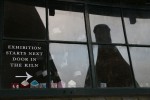I was fortunate to be part of an 18-month (2014-16) AHRC-funded project called Spirited Stoke: Spiritualism in the Everyday Life of Stoke-on-Trent (SpELS) based at the Open University. The project’s central aim was on public engagement: the production of an exhibition on Spiritualism in collaboration with active Spiritualist churches and our project partner Gladstone Pottery Museum.
Spiritualism is often depicted as a religion of the past, popularized during the Victorian era, and often visualized through the séance where people sat around a table waiting for the medium to connect with departed loved ones. Yet Spiritualism is still an active religion today. The latest UK Census numbers show that while Christianity declined, Spiritualism rose by 17% between 2001 and 2011. Regionally, the highest increase was located in the Midlands, where the SpELS project focused its attention. Stoke-on-Trent has a rich history of Spiritualism, including being the home of Gordon Higginson – the longest serving President of the Spiritualist National Union.
A key component of Spiritualism is its dissociation with materiality. This presented a challenge, considering our task was a museum exhibition. Yet we knew this, and, indeed, the exhibition was partly to challenge ourselves and others about how to display aspects of religion and spirituality that are often considered intangible.
The museum had a dedicated space for us which often acts as a workshop room, yet parts of it are Grade II* listed, limiting our ability to ‘use’ it in particular ways. We chose to change the space allocated to us and gain the assistance of a local art technician to build a living room, linking the importance of the living room as a location of Spiritualist practice from the past, and the place where most of our residential interviews with Spiritualists took place. As museum visitors explored the living room, they were encouraged to watch TV reports on Spiritualism, sift through newspapers where Spiritualism articles could be found, lift up the telephone receiver to hear stories from our Spiritualist participants, go through books on the bookshelf that reflected those found in our participants’ homes, and listen to music that can be heard at contemporary Spiritualist church services and healing services. Outside the living room was a living ‘Memory Tree’ where visitors could leave thoughts to departed loved ones. The museum also let us use a kiln which enabled us to experiment with audio; its space and acoustics contributed to building up an atmosphere that featured recordings of some of our Spiritualist participants recounting how they first got involved in Spiritualism.
Alongside the exhibition, events took place in the museum where visitors had the opportunity to experience Spiritualist practices in a public setting, outside the confines of a church. These events included participating in mediumship demonstrations, obtaining healing and engaging in Spirit Art.
The exhibition at Gladstone Pottery Museum took place in September and October 2015. For more information, visit the Talking with the Dead website where the exhibition has been archived.

